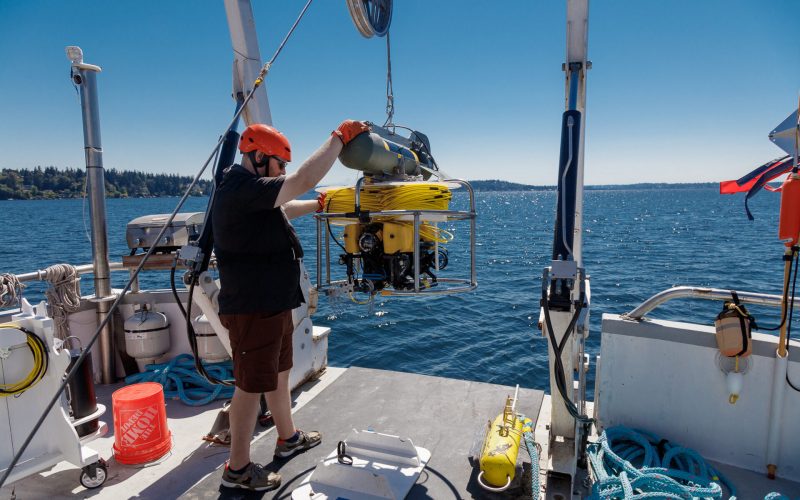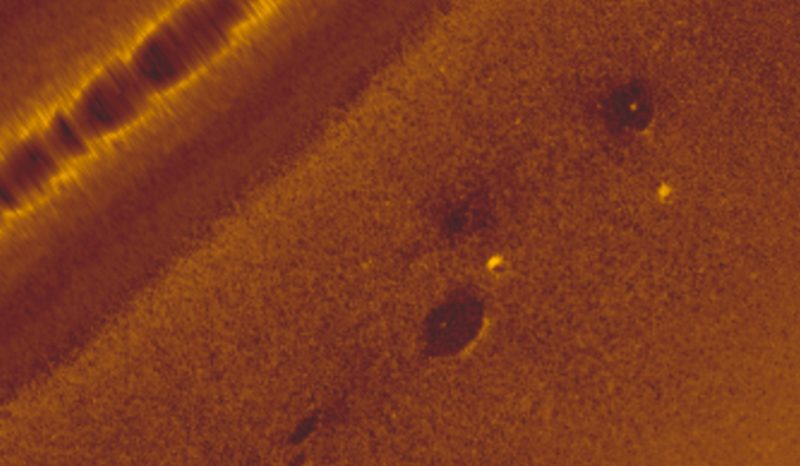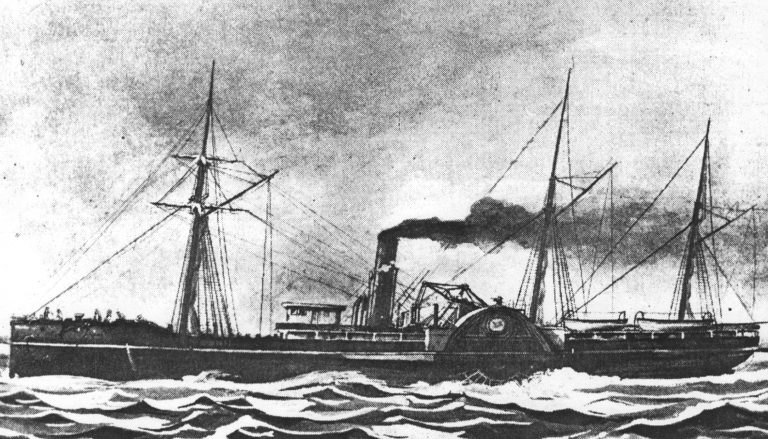
Historic Sunken Steamship Found in Pacific Northwest
The remains of a steamship that sank in the Pacific Northwest in 1875 have been discovered approximately 40 miles south of Cape Flattery, WA. Headed by Jeff Hummel and Matt McCauley, the team from Rockfish, Inc. has discovered the wreck of the SS Pacific, a steamship that operated between San Francisco, Victoria, BC, Seattle and Tacoma. The discovery is the culmination of Hummel’s 30-year search, and the team’s twelve search expeditions conducted between 2017 and 2022.
Several other groups have looked for the wreck, with the first known search being conducted in 1985. Each used their own metrics to cover a broad area, but none were successful. As part of their process, Rockfish interviewed dozens of commercial fishermen to see what they may have recovered in their bottom-trawling nets. Occasionally, fishermen would find coal, the chemical analysis of which indicated it was from a mine operated by Goodall, Nelson, and Perkins, owners of the SS Pacific. Eventually Rockfish identified a search area of approximately 13 x 26 miles, which was later narrowed down to an area of 1 x 2 miles.

The team first imaged the wreck site in October 2021 using sonar survey. Although the result did not appear to be a shipwreck, it did warrant further imaging. Weather conditions made this impossible until July 2022, at which time Rockfish deployed two custom-built ROVs. Despite multiple video surveys of the area, the nature of the target was still unclear until, during one of the surveys, the ROV was manipulated to grasp samples that were then identified as wood from the main portion of the wreck.

Last month, Rockfish, Inc. (and its associated nonprofit the Northwest Shipwreck Alliance) was granted exclusive salvage rights to the wreck. Its exact location is undisclosed, and there is a court order preventing other competing operators from entering the area. But the discovery has opened a new chapter in one of the nation’s most significant maritime tragedies.
While on a routine journey, the SS Pacific collided with the sailing vessel Orpheus, approximately 40 miles southwest of Cape Flattery. She carried an estimated 275 passengers and 50 crew. Within 20 minutes of the accident the Pacific foundered and sank. Only two people survived to tell the story.
The SS Pacific was an 876-ton side-wheel passenger steamship built in 1850 in New York. She was 233 feet long with a beam of 33 feet, six inches. The wooden-hulled ship was initially put to work during the California Gold Rush, running between San Francisco and Panama. Then in 1861, while servicing a run from San Francisco to the Columbia River, she struck a rock and sank. She was raised and taken to San Francisco for repairs and continued to work until 1872, at which time she was retired and cast aside to rot in the mud. When gold was found on the Stikine River in British Columbia, the Pacific was resurrected to carry miners and speculators to Canada. Under her new owners she was rebuilt for a cost of $40,000. Although the work was mostly cosmetic, the ship was proclaimed seaworthy by the US Steamboat Inspection Service and licensed to carry 203 passengers and a crew of 52. Thus, she would sail under the captaincy of Jefferson Davis Howell, a veteran of the Civil War and brother-in-law of Jefferson Davis, president of the Confederate States. Her route would be the PNW, between San Francisco, Victoria, BC, Seattle and Tacoma.

Washington State’s Historylink.org documents that upon leaving Esquimalt, BC, on the morning of November 4, 1875, the Pacific carried an estimated 325 souls, 2,000 sacks of oats, 300 bales of hops, 261 animal hides, 11 casks of furs, 31 barrels of cranberries, 10 cords of wood bolts, 280 tons of coal, 18 tons of general merchandise, 10 tons of sundries, six horses, two buggies, two cases of opium and a strongbox containing $79,200 in cash. It is also believed that the gold carried by passengers amounted to a value of more than $100,000.
There are conflicting details as to the exact sequence of events, but all agree that the 25-year-old Pacific was overloaded and unbalanced, and that to counteract her heavy listing, the captain had ordered two port-side lifeboats be filled with water. Also, as night closed in, her only running light was the white light at the top of the mast. It was this light, spotted by the watch crew aboard S/V Orpheus, that led to the calamity that followed.
While Orpheus‘s captain was belowdecks checking charts ahead of their turn toward the Strait of Juan de Fuca, the watch crew were under instruction to “starboard the helm” if they saw a light. Mistaking the Pacific‘s masthead light for the Cape Flattery Light, the crew notified the captain. Again, there are variations in the accounts of who turned the ship, but the action put the Orpheus in the path of the Pacific. Neither vessel was aware of the other until it was too late. The Pacific reportedly attempted to reverse, but a collision was imminent.
Though it appears the contact was relatively slight, it was repeated “with the Pacific‘s bow striking the Orpheus just aft of the main hatch, before glancing off and again striking her further aft at the mainmast shrouds.” As the two ships ran broadside against each other, the Orpheus took a third hit, this time at the mizzenmast chains. Then, as quickly as they had met, the two vessels continued on their opposite paths.
Soon after the collision the Pacific broke up and began to sink; all but two of her passengers and crew were lost to the sea. There are reports that the vessel was unsound, that the water-filled lifeboats contributed to the deaths as people unsuccessfully launched them from the ship, and that the accident occurred in the first few hours of a 100-year storm. Whatever the details, at that time the disaster represented the largest marine loss of life on the West Coast, a claim still held today.
The salvaged remains of the SS Pacific will reside with the Northwest Shipwreck Alliance, and will become the centerpiece of a maritime museum the organization intends to build in Seattle.
If you’re interested in shipwrecks, particularly those in San Francisco Bay, tune in to our Good Jibes podcast with Brian Crawford on “Exploring Shipwrecks.”

Nice article on a tragic piece of West coast maritime history. One small suggestion: I suspect you meant to write that she “foundered and sank.” Unless, of course, an unusually large school of unusually large flounder in an unusual location for flounder played a role in the incident.
Well if this is the sole mistake of this whole article then the halibut!…. I’ll see myself to the door.
This is great, Thanks David ?
Yes, technically, the word foundered is specific to ships: foundered
(of a ship) fill with water and sink: “Six drowned when the yacht foundered off the Florida coast”
Though if you look up the word, “flounder” in the dictionary, it can also be applicable: “to struggle with stumbling or plunging movements (usually followed by about, along, on, through, etc.): “He saw the child floundering about in the water.”
We’ll take this onboard as a lesson in sailing semantics. 🙂
What happened to the Orpheus?
Thanks for the question Jeff. The Orpheus was apparently repaired under way, but later ran aground. Perhaps we’ll do a follow up story with more detail.
Nice piece. Well done!
Very interesting article. What is the depth of the wreck?
Also, is there much known of the 2 survivors?
All we have been shown so far is some side-scan images. Although convincing, they are far from verifying the wreck has been located. When will photos/video of the wreckage be made available? Also, is it inside or outside of the Olympic Coast National Marine Sanctuary?